By now, everyone reading this blog should be aware of the crisis in oil markets. If not, this week’s spectacular collapse of the May WTI contract almost certainly caught your attention.
I’m not the first to say this, but it’s worth repeating: the WTI settlement of -$37.63 a barrel was the result of traders’ difficulty exiting positions ahead of expiry. It turns out that it’s pretty hard to sell something if you don’t have a buyer, and broad-based expectations for Cushing to run out of crude storage capacity in the coming weeks explain why there were so few buyers.
If you’re looking for signs of distress in the market, look no further to what happened on April 20.
$47 billion in E&P capital expenditures slashed
Amid this unprecedented situation, oil producers here in the United States and elsewhere have been forced to reassess their priorities. Right now, the highest priority is cash conservation.
Our latest research shows that among 42 publicly traded U.S.-based E&Ps, as well as three oil majors with U.S. operations. About $47 billion in capital expenditures were cut from budgets as of late April—a reduction of 31% from initial investment plans. The scary thing is that even more cuts are likely in the offing.
Because of the drop in upstream investment, U.S. rig count has been gutted. There are currently only 508 active rigs operating in the U.S., down roughly 40% from the end of last year. No place in the U.S. has been spared from declines, although the drop in the Permian has been particularly striking.
Given the scale of the crisis and the speed at which it is happening, even OPEC and allied non-OPEC countries were forced to pivot from their previous course. Starting in May, the OPEC+ countries agreed to take 9.7 MMBD off the market compared to their agreed baseline. Compared to February production though, this cut only amounts to a 7.1 MMBD but is nevertheless unprecedented in its size. The cuts rachet down through April 2022.
Too little, too late
Despite their unprecedented size of the OPEC+ production cuts, the cuts are still too small and will take effect too late to prevent the worst-case scenario from happening in physical markets.
Global petroleum demand will contract by 8.7 million b/d this year compared to 2019
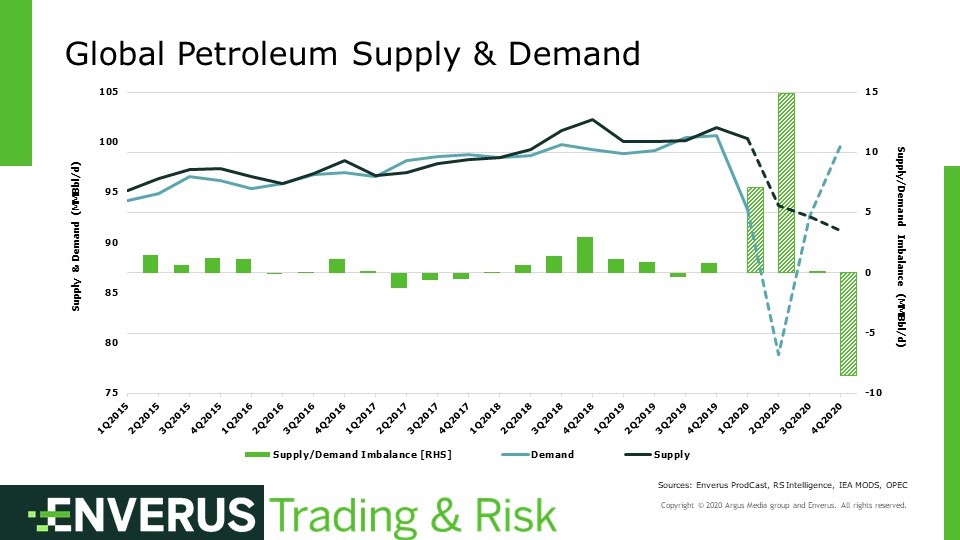
Under Enverus’ base case, global petroleum demand will contract by 8.7 MMBD this year compared to 2019. However, the lion’s share of those declines is concentrated in the second quarter. Second quarter demand is expected to average 20.3 MMBD lower than the same period in 2019. Remember, that is an average for the quarter. April data are not in yet, but we’re looking at a contraction of close to 30 MMBD for just that one month compared to April last year.
Meanwhile, liquids production remains well in excess of demand despite the production cuts that are underway. Even after OPEC+ production cuts and forecasted declines elsewhere, we still have a surplus of close to 15 million b/d in the second quarter. This is an astonishing amount of liquids that have no place to go other than into storage.
How prices respond to a situation that dwarfs everything that came before it
Notice the recovery in demand in the second half of the year. This is not entirely certain, and there are still considerable downside risks to this outlook. Nevertheless, if demand were to recover anywhere close to where it was before most of the world’s economy went into lockdown, then we could end up with some very large implied inventory draws in the fourth quarter. And if global liquids demand averages close to 99 MMBD in 2021, we could end up seeing continued inventory draws next year given the amount of supply that is being driven asunder by today’s horrendous price environment.
So, what would all of this do to prices and how would U.S. production respond?
Using Enverus ProdCast, we ran a crude production model under different price assumptions for WTI.
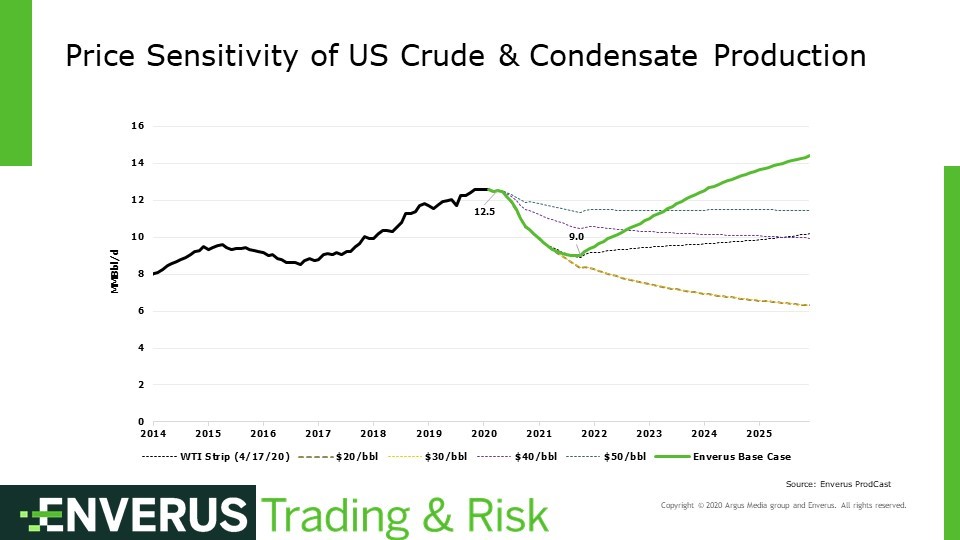
This chart plots U.S. production using April 17, 2020, settlements as well as different flat price scenarios of $20, $30, $40, and $50 a barrel.
For the immediate future, U.S. production has nowhere to go but down. And that’s essentially what today’s price environment does. It pushes the U.S. tight oil production into natural decline.
Between now and the fourth quarter of 2021, the U.S. could lose 3.5 million b/d production due to natural declines alone. That’s a long way to fall. After that, production begins to rise again under our base case assumptions. Note how much longer it takes this production to recover back to its prior peak than it did before. To get production to ramp back up, prices have to do some pretty heavy lifting.
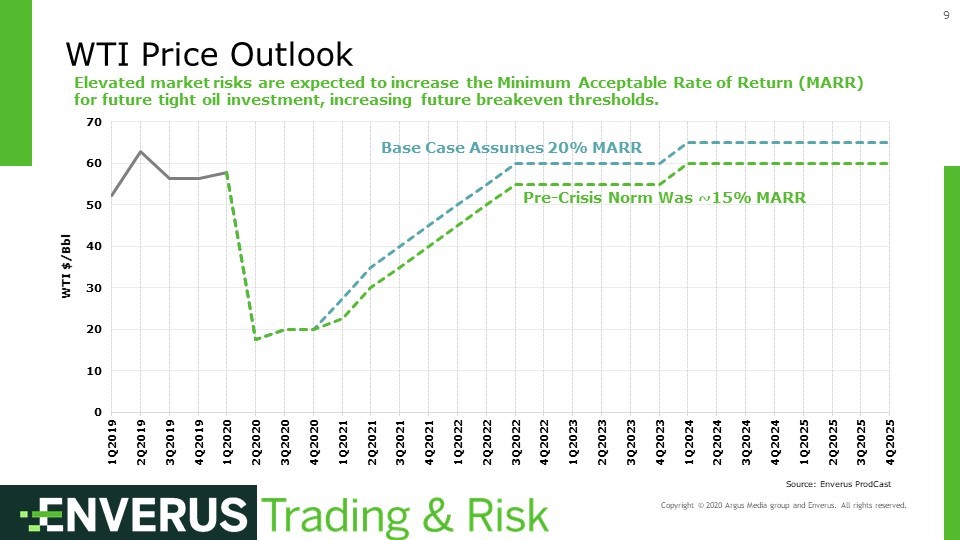
We reverse-engineered ProdCast to give the prices necessary to call forth that production. The blue line here is the price set that was used to create the Enverus base case in the previous chart after the historic rout the markets is currently undergoing. One could argue that it would take an awful lot of guts for an E&P to go back out in the field and drill a new well, even after the worst of the pandemic is over.
The perception of market risk would be too much to handle for a firm and for many to get over before the crisis. Many operators would have been content with their capital cutting decisions at around 15% at minimum. In the not-so-distant future, operators may need greater assurances that their capital will not go to waste. Hence why this forecast was based on a minimum acceptable order to return of 20%.
Looking ahead to oil market and production recovery
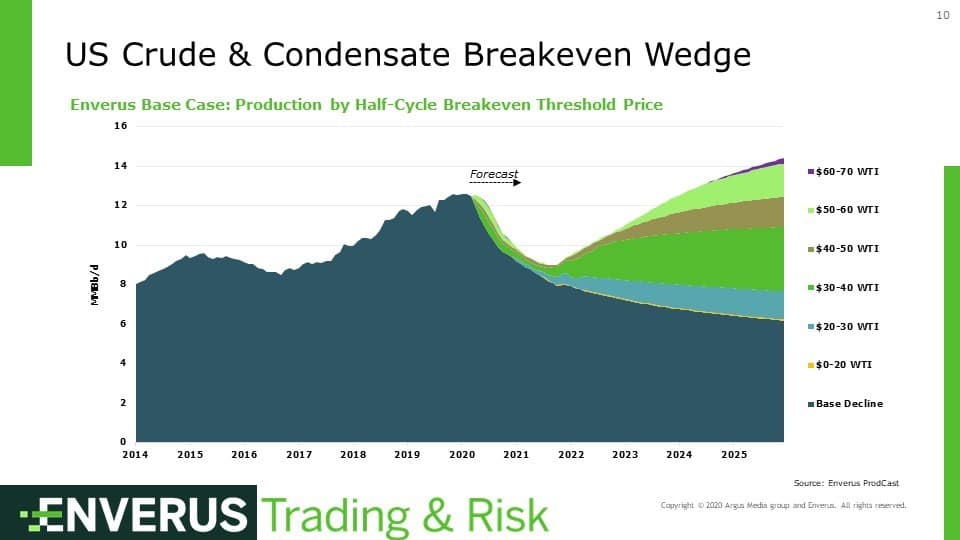
The chart above shows how production in the U.S. ramps up as prices recover. We start with wells that break even when WTI is below $20 a barrel. We run out of those sweet spots pretty quickly. The next tranche of supply comes from wells that break even between $20-$30 a barrel. Well, we run out of those pretty quickly, too. The greatest amount of volume comes online between $30-$40 a barrel. But that is not likely to be enough of an if global demand is fully on the mend and 2023. In fact, it is possible that we could need at least two additional tranches of supply above that in order to balance the global market at that time.
This is what gives us the price outlook that is almost unthinkable as we sit here in the middle of the deepest downturn in the history of the industry. But remember, it’s easier for a drop in prices to send U.S. tight oil production into natural decline than it is for prices to get production back to its prior peak. This is what drives that rebound in prices I showed previously.
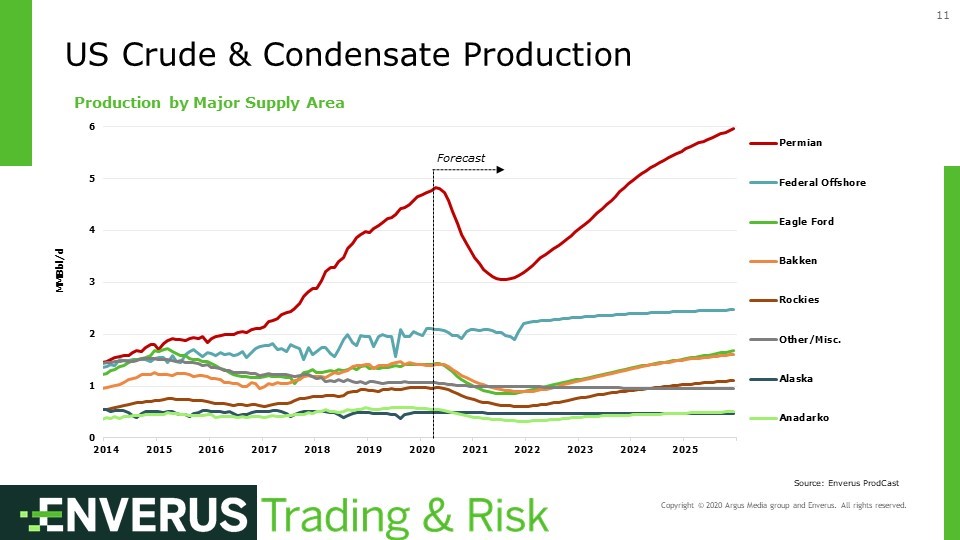
Let’s look at what this base case does to production at the basin level. Here we see that the largest production declines in the months ahead are going to be concentrated in the Permian Basin. This has less to do with economics as it does with the relatively newer vintage of the wells and production there. The economics of production are actually very compelling, especially in the Delaware Basin. And that’s why we see the Permian taking the lead during the recovery. But the preponderance of newer vintage wells means that those immediate declines are going to be quite steep.
Still not enough
The pain gets worse in the near term, unfortunately. Remember, the second quarter global supply-demand balance already factored in these near-term natural declines in U.S. production and we still have global inventories bursting at the seams. By our estimates, Cushing should be effectively full by mid-May. If crude runs continue to fall and average refinery utilization in the United States hits 50%, virtually all commercial storage capacity will be filled by the end of next month in PADDs 2 and 3.
This brings us to the need for even more drastic cuts to production in the immediate future. Shut-ins are going to be needed in addition to natural declines. The chart below uses data from RS Core to break down the U.S. Lower 48 into different regions, plotting cumulative production in each of these areas along the x-axis and variable operating expenses on the y-axis. As prices in the field fall below variable OpEx, upstream operators have already begun assessing which wells to shut in. Low volume, high OpEx wells are likely to be some of the first wells on the chopping block.
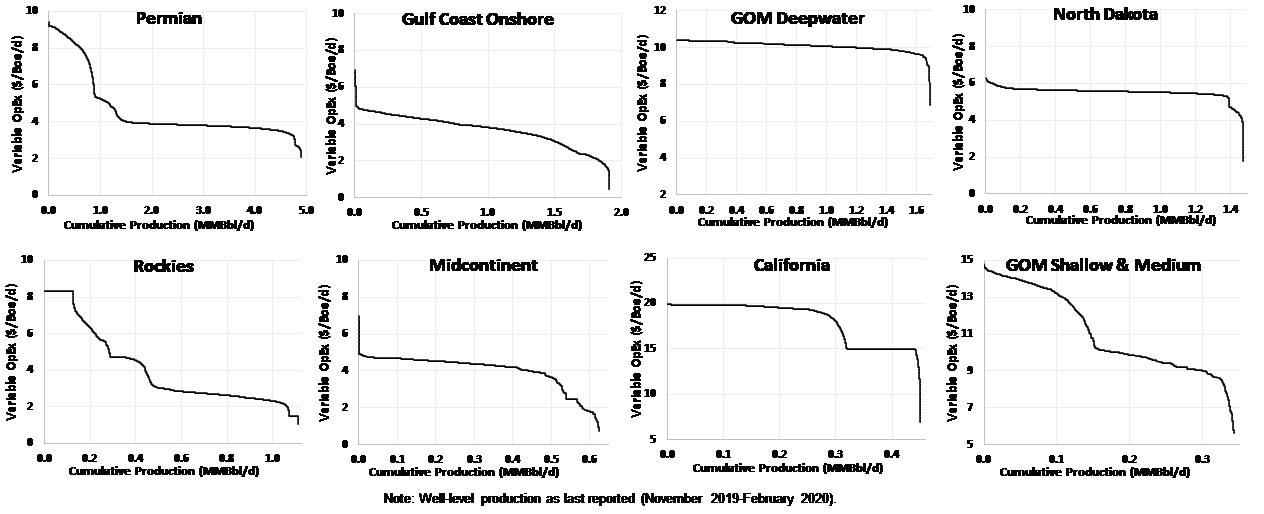
Shut-ins present a unique challenge when it comes to production forecasting. On the one hand there are wells that have high costs to operate and/or low production volumes, but for a myriad of reasons may not be on the chopping block. For example, the lease could be held by production, or there could be abandonment issues with state regulatory bodies.
Still, the need for immediate shut ins is great. RS Energy Group, a part of Enverus, recently published a great report on this. According to them, roughly 1.4 MMBD of U.S. production comes from wells producing less than 20 bbl/day. These wells are spread out across the U.S., but some key standout areas are the Central Basin Platform, Midland Basin, and the San Joaquin basin.
No pain, no gain
To conclude, the OPEC+ production cuts are not going to be enough and the impact of an oversupplied market are going to be particularly severe here in the United States. Tight oil base declines are also not going to be enough to balance sharply lower demand, necessitating shut-ins. This is going to be a game changer in the weeks ahead, and something necessary to jump-start the recovery in prices later down the road.
Unfortunately, the crisis we are living through today is going to leave deep scars on the American oil and gas industry. Ultimately, upstream operators are going to think long and hard about future capital expenditures and are likely going to require higher returns before going back into the field. This too should prove supportive for prices once the worst of the current downturn is over.





